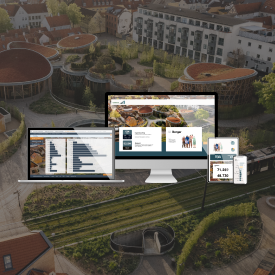Improved Service to Citizens
Modern municipal operations have long been a highly complex issue that hinges on effective data sharing and use for both city employees and citizens. With 70 local services, such as daycare centers, schools, and senior citizen centers, Denmark’s municipality of Skanderborg needed a more efficient way to give power over data to government managers throughout the municipality, and open the door to entirely new opportunities to identify, analyze, and act on problems.
ALSO WATCH: Skanderborg Kommune: How We Organize BI (Danish Webinar)
Skanderborg Municipality chose TARGIT Decision Suite's custom analytics solution for municipalities, which was selected to help to change the way the municipality collects, organizes, and works with data.
Each of the municipality’s 70 government-funded centers has been provided with TARGIT licenses, with more than 400 employees in total currently using Decision Suite to give them a better understanding not only of their own department and center but of their progress and efficiency in the entire municipality.
In the past, Skanderborg Municipality relied on external IT consultancy to help them wrangle data. “It had been such that workflow would adapt to available data,” says Lars Leth, Former Economist at Municipality of Skanderborg.
Leth previously headed the municipality’s TARGIT implementation. “Now we would like to see it going the other way; that data adapts to the users. This will ultimately save taxpayers money because the municipality is far better equipped to collect knowledge from data.”
With TARGIT Decision Suite, Skanderborg Municipality can easily pull reports, analyses, and dashboards from the massive amount of data that’s available from each center to get the answers they need. Data will now be better tracked and analyzed, making it possible for strategic future planning based on facts instead of just opinion and conjecture.
Municipality services will be benchmarked for improvement. By benchmarking schools or institutions, for example, municipality leaders can zero in on problems that might be affecting particular locations, such as high absenteeism or improper resource allocation. TARGIT users can drill down from a general overview into the granular details of individual departments, staff, and days, helping employees identify exactly where deviations occurred and why.
With the integrated TARGIT Data Service tool, it will even be possible for users to pull data down from other regions in Denmark or from external data sources such as Statistics Denmark, external spreadsheets, and social media and mash up that data to be analyzed alongside their own data.
In addition, several new municipality areas are on the drawing board, including an “economic benchmark” model and a cross-sectional analysis cube which will bind all data from the specialized systems together with economic data. This makes it possible to perform analyses across disciplines, including effectiveness analyses, so the municipality can follow the costs to produce various kinds of welfare services across organizations.
“Previously, we have not been able to look across our systems, but we will be able to now,” says Leth. “It will provide some tremendous benefits, also in relation to the service we provide to citizens. Decompartmentalized thinking will be increasingly replaced by collaborations across the local authority areas, and we must be able to support with data.”
TARGIT was initially rolled out in the municipal absence area. The solution has now been rolled out at several departments within the administration of the municipality. This means that more than 400 decision-makers are now able to make data-driven decisions and present data and insights better than ever before.
.png)

/Listing%20img%20275x275.png)


